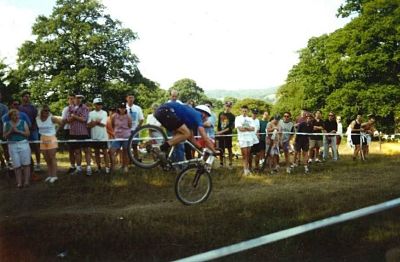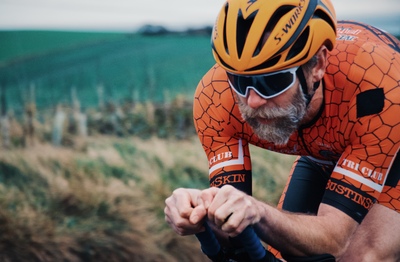In 1994, Graeme Obree successfully broke the world hour record on a homemade bicycle he’d put together with leftover scrap and some old bearings from a washing machine.
Despite race officials attempting to block him intermittently as he rode around the track and the governing body trying to legislate him back into obscurity, this was a man who had the foresight to focus on the problem associated with going as fast as possible on a bike and the instincts to know how best to find a solution, no matter how radical.
When it comes to getting faster, there’s always a raft of cool equipment to buy or upgrade to. Sadly, if you were hoping I was going to recommend buying wheel X or handlebar Y in this article, you’re going to be disappointed.
Ultimately, I want to highlight some common problems you might wish to avoid and share an approach for improving your performance package…
Be problem centred, not product centred
One of the mistakes many athletes make is that they get hung up on seeking the ‘next best thing’, such as the newest, fastest or lightest product, but then lose sight of what they’re trying to do.
Before you buy the latest fad, you need to clearly identify the problem to ensure any change will be worthwhile.
Sometimes your budget is going to be limited and you’ve stretched your physical abilities as far as they’re going to go. With this in mind, I typically propose that athletes should focus on two basic fundamentals:
- Maximise factors that increase speed
- Reduce any resistance working against them
In cycling terms, I’d strongly suggest you need to consider the following factors when looking to make your bike go faster:
- Maximise power output (physical training and bike fit)
- Reduce overall aerodynamic drag
- Reduce rolling resistance of the tyres (width, texture and materials)
- Maximise drivetrain efficiency (chain lubricants, high quality bearings, sprocket sizing and chain line)
- Reduce any rotating mass (e.g. wheels)
- Reduce any overall weight (bike and rider)
- Reduce of physiological fatigue (vibration, soreness, ability to hold position)
- Equipment reliability (e.g. puncture resistance, breakages)
The importance of these factors over one another will vary based on the type of cycling or racing you’re doing.
Tailor your 'suit' to you - don’t go off the peg
It’s tempting to follow the herd when the next best innovation comes out. Being an early adopter can be a good decision sometimes (e.g. aerobars in the late 80’s being one), but it can also be a bad call (my cheap first power meter in 2006 was barely more than a random bingo number generator). Fun fact: My current bike computer actually has more processing power than when Apollo 11 went to the moon in 1969 - that’s progress for you.
Crucially, the best performance solutions have to deal with physics and these don’t bend for anyone. And the product has got to be used by a human being. We’re emotional, irrational and chaotic little blighters. As a result, I always advocate selecting equipment based on your own personal needs, even if your choice isn’t actually the best on paper.
For example, I openly concede that my off-road technical skills were never the best – I have the turning circle of Jupiter’s orbit around the sun and the reaction time of an electrocuted cat. This means I’m barely in control half the time and twitchy when surprised. Check out this old photo of me underestimating my jumping skills coming out of the exit of the infamous downhill bombhole at the Malverns MTB festival back in ‘95. Five degrees away from taking out a crowd of spectators, I actually stayed rubber side down but I needed a change of underwear afterwards...

As a result, I now have a tendency to slightly ‘overbike’ for a lot of my gravel riding events so that I can ride flat out with confidence. I’ve used slightly wider tubeless tyres than most for added grip and suspension, whilst also running inserts to minimise puncture worries. The trade-off was a little extra weight and maybe some extra rolling resistance but for me it’s the best net performance choice.
I’ll also run aerobars, an aero helmet and a skinsuit when the event rules allow it because even at the relatively slow speeds you see off-road, aerodynamic drag has still been shown to be a factor.
Speaking of gravel racing, this is taking me back full circle to where many of us were with mountain biking back in the early 90’s. Gravel races and equipment are evolving quickly. My recommendation is always to look at the race itself, not just its label, and take into account your goals and then plan your equipment accordingly. One gravel race isn’t the same as another, in the same way that equipping for a hilly triathlon bike leg in Nice is radically different to a windy one held in Hawaii.
For example, Lael Wilcox won the 2021 Unbound Gravel race on a MTB hardtail with suspension forks - not a gravel bike. Conversely, Geoff Kabush won the 2018 Iceman Cometh mountain bike race… on a gravel bike. They went with what was best for them and did their homework on the race they were targeting, balanced against their needs and abilities.
The pitfalls of fashion and fads
Fashions and fads can be a powerful driver in consumer behaviour, even in scientific environments like competitive sport. I’ve been as guilty of this as anyone.
Back in ’04, I changed my time trial bike set-up to match that of pro cyclist Jan Ullrich’s. This featured straight and downward tilted aerobar extensions, undersized frame and a riding position that looked like it was bulldozing snow rather than scything through the air.
Ullrich’s chequered past aside, I identified with his size and style of riding and then attempted to copy it. It wasn’t until I spent some time in a wind tunnel a few years later that I realised how much time that cost me. This said, some of my recent research found that some psychological gains – such as product customisation, colour, style and co-creation can actually be desirable to cyclists and therefore potentially improve their performance.
In the main though, form should always follow function.
The best cycling enhancements are ‘invisible’
In many ways, the most recent performance enhancements I’ve enjoyed are not the latest piece of carbon-based goodness but those that go relatively unnoticed.
For example, my professional opinion is that the aerodynamic design of the bicycles we use has already peaked so the real gains lie elsewhere. A 2017 crowdfunded wind tunnel study on the Slowtwitch forum confirmed this by demonstrating that if you’d bought a top drawer tri bike in the last 10 years, it’s pretty much a wash between them.
Therefore, the best gains actually lie outside of the bike and wheels, and should be focused instead on optimising your aerodynamic riding position, which probably costs less than a new bike. Consider for a moment that 64-82% of your total drag is from the human body. A new aero bike fit might be less sexy and obvious than a new wheel but it’s likely to be more useful to you in a race.

Fabric textures have also produced some of the less obvious and yet most important aerodynamic benefits of the last 10 years. This makes sense because what works in product design is often copied from what we see in the natural world around us – a shark’s skin being a good example.
This kind of inspiration is known as ‘biomimicry’ – and natural selection tells you what works because you don’t survive as a species for a few million years unless you’ve developed the skills of avoiding being killed by something faster or larger. Ever heard of the Broad‑faced Potoroo? No? There you go.
When it comes to fabric textures the skinsuits used by Team GB’s all conquering track team at the 2008 Olympic Games were intentionally shredded immediately after the competition to avoid other nations copying the technology, while it pains me when I see a rider with a zip down and the whole thing flapping in the breeze – it’s just throwing away free speed.
Back in the day, I purely aimed to ensure my suit was tight. Now, my current skinsuit has textures and seam placement to help manage the airflow around me but makes me stoop like the Hunchback of Notre Dame. If someone ever set me on fire, I’d be dead long before I’d managed to get the zip down by myself.
So, what can we take from all of this? And why didn’t I tell you which front wheel was actually fastest?
It’s because the fastest bike is relative. The important takeaway is that whatever you go for needs to have an evidence-based approach, support your past experience and future goals, and not be an exercise in fad, fashion or guesswork.
